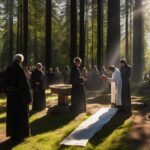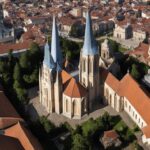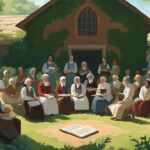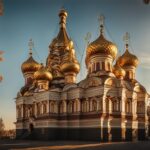The history of the medieval church is a fascinating journey through time that explores the origins and founders, key beliefs and doctrines, historical significance, denominational split or schisms, leadership and governance, worship practices, contemporary influence, and current world membership number and percentage of world religions. This article will delve into each of these aspects to provide a comprehensive understanding of the medieval church and its lasting impact on religious history.
Key Takeaways:
- The medieval church played a significant role in European history, serving as both a religious institution and a powerful political and social force.
- The founders of the medieval church were early Christian apostles, such as Peter and Paul, who spread the teachings of Jesus Christ.
- Key beliefs and doctrines of the medieval church included the Holy Trinity, the divinity of Jesus Christ, the authority of the Bible, and the importance of sacraments and salvation.
- The medieval church experienced denominational splits or schisms, leading to the formation of separate branches within Christianity.
- The leadership and governance of the medieval church were hierarchical, with the pope at the top of the hierarchy.
- Worship practices of the medieval church centered around the celebration of the Mass and emphasized the importance of sacraments.
- The influence of the medieval church can still be seen in the architectural wonders and religious art of the era.
- The current world membership of the medieval church is estimated to be the largest among Christian denominations, with over 1.3 billion members worldwide.
Origins and Founders of the Medieval Church
The medieval church finds its roots in the early centuries of Christianity, when the religion began to spread throughout Europe. The founders of the medieval church were the early Christian apostles, including prominent figures like Peter and Paul, who dedicated their lives to spreading the teachings of Jesus Christ. These apostles played a pivotal role in establishing the church and laying the foundation for its growth and influence.
As Christianity gained traction, the church gradually evolved into a powerful institution that became an integral part of European society. It provided spiritual guidance, social structure, and a sense of stability during a time of political unrest. The church’s influence expanded, and it played a significant role in shaping the religious, cultural, and political landscape of medieval Europe.
Throughout its history, the medieval church went through various transformations and reformations, adapting to the changing needs of its followers. It weathered denominational splits and schisms, including the Great Schism of 1054, which resulted in the separation of the Western (Roman) Catholic Church and the Eastern Orthodox Church. This division marked a crucial turning point in the history of the medieval church and led to the establishment of distinct branches within Christianity.
| Origins and Founders of the Medieval Church | Key Points |
|---|---|
| Founders | Early Christian apostles, such as Peter and Paul, who spread the teachings of Jesus Christ. |
| Evolution | The church gradually gained influence, becoming an integral part of European society. |
| Influence | The medieval church played a significant role in shaping the religious, cultural, and political landscape of medieval Europe. |
| Denominational Splits | The Great Schism of 1054 resulted in the separation of the Western Catholic Church and the Eastern Orthodox Church. |
“The medieval church owes its origins to the early Christian apostles, who dedicated their lives to spreading the teachings of Jesus Christ.”
Key Beliefs and Doctrines of the Medieval Church
The medieval church was guided by a set of key beliefs and doctrines that shaped its teachings and practices. These beliefs were fundamental to the Christian faith and formed the basis of the church’s teachings to its followers.
One of the central tenets of the medieval church was the belief in the Holy Trinity. This doctrine affirmed the existence of the Father, the Son (Jesus Christ), and the Holy Spirit as three distinct persons in one divine being. It emphasized the unity and co-equality of the three persons, highlighting the divinity of Jesus Christ and the importance of the Holy Spirit in guiding and sanctifying believers.
Another key belief of the medieval church was the authority of the Bible. The church regarded the Bible as the inspired word of God and the ultimate source of divine revelation. It taught that the scriptures contained the truth necessary for salvation and guidance in living a righteous life.
The medieval church also placed great emphasis on sacraments as essential means of experiencing God’s grace. Sacraments such as baptism, confirmation, Eucharist (Communion), penance, anointing of the sick, ordination, and matrimony were considered sacred rituals that connected believers to God’s divine presence. These sacraments were believed to confer spiritual blessings and were administered by priests who acted as intermediaries between God and the faithful.
The teachings of the medieval church also emphasized the concept of salvation through faith and good works. It taught that salvation was a result of both God’s grace and human cooperation. Believers were expected to have faith in Jesus Christ and actively participate in acts of charity, devotion, and obedience to God’s commandments.
In summary, the key beliefs and doctrines of the medieval church revolved around the Holy Trinity, the authority of the Bible, the importance of sacraments, and the concept of salvation through faith and good works. These beliefs played a central role in shaping the medieval church’s teachings and practices, providing a framework for spiritual growth, moral guidance, and the pursuit of eternal salvation.
Historical Significance of the Medieval Church
The medieval church holds immense historical significance, influencing various aspects of European history. As both a religious institution and a political force, it played a pivotal role in shaping the development of European society and culture.
One of the primary ways in which the medieval church left its mark was through its impact on art and architecture. The construction of grand cathedrals and churches showcased the immense wealth and power of the church, while also serving as centers of religious devotion and pilgrimage. The architectural marvels, adorned with intricate stained glass windows and ornate sculptures, continue to captivate visitors to this day, providing insights into the religious beliefs and artistic skills of the medieval period.
“The medieval church’s influence extended beyond religion, art, and architecture, leaving an indelible mark on education and the legal system of the time.”
Furthermore, the medieval church played a significant role in providing stability and unity during a time of political turmoil. It served as a unifying force, offering a sense of community and belonging to individuals across different social classes. The church’s teachings and rituals provided a moral and ethical framework for medieval society, guiding individuals in their daily lives and interactions.
The Influence on European History
The medieval church’s influence extended beyond religion, art, and architecture, leaving an indelible mark on education and the legal system of the time. Monastic schools and cathedral schools were established, providing education to clergy and the upper class. These centers of learning preserved ancient knowledge, advanced scholarship, and laid the foundation for the development of universities in later centuries.
The church also exerted control over the legal system, influencing legislation and serving as the moral authority. Ecclesiastical courts, separate from secular courts, dealt with matters of religious doctrine and sacramental practice, exerting their influence over both clergy and laity. The church’s role in law and justice helped maintain social order and ensured the enforcement of moral standards.
In summary, the medieval church’s historical significance is evident in its influence on European art, architecture, education, legal systems, and societal unity. Its impact continues to shape our understanding of the Middle Ages and the role of religion in shaping European history.
Denominational Split or Schisms in the Medieval Church
The medieval church experienced significant denominational splits or schisms that resulted in the formation of separate branches within Christianity. These divisions had far-reaching consequences for both religious and political landscapes.
One of the most notable schisms was the Great Schism of 1054, which marked the formal split between the Western (Roman) Catholic Church and the Eastern Orthodox Church. The primary cause of the schism was a dispute over the authority of the pope and theological differences. The schism led to a lasting division between Western Christianity, dominant in Europe, and Eastern Christianity, prevalent in the Byzantine Empire and its successor states.
“The Great Schism of 1054 marked a significant turning point in the history of Christianity. It not only created two distinct branches of the church but also raised questions about the nature of authority and doctrinal differences.”
– Church Historian
Another major schism occurred during the Protestant Reformation in the 16th century. This movement, led by reformers such as Martin Luther, John Calvin, and Henry VIII, challenged the teachings and practices of the Roman Catholic Church. The Protestant Reformation resulted in the formation of various Protestant denominations, each emphasizing different theological beliefs and practices.
| Denomination | Founder | Main Beliefs |
|---|---|---|
| Lutheranism | Martin Luther | Salvation by faith alone, authority of Scripture, priesthood of all believers |
| Calvinism | John Calvin | Predestination, authority of Scripture, emphasis on God’s sovereignty |
| Anglicanism | Henry VIII (Church of England) | Episcopal hierarchy, English Reformation, combination of Catholic and Protestant traditions |
These denominational splits and schisms within the medieval church had profound and enduring effects on the religious landscape of Europe and the world. They shaped the diversity of Christian beliefs and practices, and their legacy continues to influence Christianity today.

Leadership and Governance of the Medieval Church
The medieval church was characterized by a hierarchical structure of leadership and governance. At the pinnacle of this hierarchy was the papacy, with the Pope considered the supreme head of the church. The Pope, who resided in Rome, held immense power and authority over religious matters, making decisions that influenced the entire Christian community. The papacy played a crucial role in shaping the direction of the church and appointing bishops, cardinals, and other clergy members.
Bishops and Cardinals
Below the Pope in the church hierarchy were bishops and cardinals. Bishops were responsible for overseeing the spiritual well-being of their diocese, which encompassed a specific geographic area. They presided over sacraments, provided guidance to priests, and held authority over local clergy members. Cardinals, on the other hand, were high-ranking ecclesiastical officials who advised the Pope and participated in the election of a new Pope when the position was vacated. Their role in church governance was significant, as they formed part of the College of Cardinals, which held great influence in decision-making processes.
The leadership and governance structure of the medieval church ensured a centralized authority that upheld doctrinal unity and maintained order within the Christian community. However, it also led to power struggles and conflicts, both within the church and between the church and secular authorities. The role of the clergy in governance was not without controversy and criticism, with instances of corruption and abuse of power tarnishing the church’s reputation.
In summary, the medieval church’s leadership and governance were characterized by a hierarchical structure led by the Pope, with bishops and cardinals playing crucial roles in guiding the church and preserving its traditions. This system centralized authority and provided a framework for decision-making, ensuring the unity and stability of the medieval church.
Worship Practices of the Medieval Church
The worship practices of the medieval church were deeply rooted in ritual and symbolism. The central act of worship was the Mass, a sacred ceremony that commemorated the Last Supper of Jesus Christ. During the Mass, bread and wine were believed to be transformed into the body and blood of Christ through the process of transubstantiation.
This belief in the real presence of Christ in the Eucharist was central to the spiritual life of medieval Christians. The Mass was conducted in Latin, which was the common language of the church at the time. It was a solemn and highly visual ritual, accompanied by chants, incense, and the ringing of bells.
In addition to the Mass, the medieval church placed great importance on the sacraments. These were religious rituals that were believed to convey God’s grace to the participants. The primary sacraments were baptism, confirmation, penance, matrimony, holy orders, and anointing of the sick. Each sacrament had its own set of rituals and symbols, and they were seen as essential for spiritual growth and salvation.
Overall, worship in the medieval church was characterized by its emphasis on ritual, symbolism, and the sensory experience. The Mass and sacraments played a central role in the spiritual life of medieval Christians, providing them with a tangible connection to the divine.
Influential Medieval Church: Cultural Impact, Religious Art, and Church Architecture
The medieval church left an indelible mark on European culture through its significant influence on various aspects of society. From its architectural wonders to its religious art, the medieval church continues to captivate and inspire people around the world.
Architectural Marvels
One of the most enduring legacies of the medieval church is its awe-inspiring architecture. Cathedrals and churches were meticulously designed and constructed, showcasing the remarkable craftsmanship of the time. The grandeur of Gothic architecture, with its soaring spires, intricate details, and majestic stained glass windows, evoked a sense of wonder and reverence. Each structure was a testament to the spiritual devotion and artistic skill of the medieval craftsmen.
| Architectural Features | Examples |
|---|---|
| Flying Buttresses | Notre-Dame Cathedral (Paris, France) |
| Ribbed Vaulting | Canterbury Cathedral (Kent, England) |
| Gargoyles | Chartres Cathedral (Chartres, France) |
Inspiring Religious Art
Religious art flourished during the medieval period, serving as a powerful tool for conveying the teachings of the church to the illiterate masses. Iconic masterpieces, such as religious paintings, sculptures, and illuminated manuscripts, were created to evoke deep spiritual emotions and inspire piety. Rich in symbolism and detail, these artworks depicted biblical stories, saints, and religious figures, becoming conduits for religious devotion and contemplation.
“The purpose of art is washing the dust of daily life off our souls.” – Pablo Picasso
Cultural Influence
The cultural impact of the medieval church extended far beyond religious practices. It shaped the moral and ethical values of European society, influencing social norms, education, and the legal system. Monastic orders established schools and universities, preserving knowledge and fostering intellectual development. The church’s patronage of the arts led to advancements in painting, sculpture, and music, leaving an indelible cultural legacy that continues to resonate today.
The influence of the medieval church, with its remarkable architecture, inspiring religious art, and cultural impact, remains a testament to the enduring power of faith and artistic expression.
Current World Membership Number and Percentage of World Religions
The medieval church, with its rich history and profound influence, continues to have a significant presence in the world today. While it is challenging to determine its current world membership with absolute precision, the Roman Catholic Church, which emerged from the medieval church, stands as one of the largest Christian denominations worldwide.
Estimates suggest that the Roman Catholic Church boasts over 1.3 billion members, comprising a considerable percentage of the global population. This remarkable figure speaks to the enduring legacy and widespread reach of the medieval church’s teachings and traditions.
As Christianity evolved and diversified over time, various denominational splits and schisms occurred, leading to the formation of separate branches within the faith. Despite these divisions, the medieval church’s influence remains palpable, uniting millions of believers around the world under the umbrella of Catholicism.
While the medieval church’s membership continues to grow, its impact extends beyond sheer numbers. The cultural, architectural, and artistic heritage of the medieval church still resonates in contemporary society, reminding us of the profound influence it has had on shaping our world.
FAQ
What is the history of the medieval church?
The medieval church traces its origins back to the early centuries of Christianity when the religion began to spread throughout Europe. The founders of the medieval church were the early Christian apostles, such as Peter and Paul, who spread the teachings of Jesus Christ. The church gradually gained influence and power, becoming an integral part of European society.
What were the key beliefs and doctrines of the medieval church?
The medieval church had key beliefs and doctrines that formed the foundation of its teachings. These included the belief in the Holy Trinity, the divinity of Jesus Christ, the authority of the Bible, the importance of sacraments, and the concept of salvation through faith and good works. The medieval church also emphasized the role of priests and the sacraments in facilitating spiritual growth and salvation.
What was the historical significance of the medieval church?
The medieval church played a significant role in European history. It was not only a religious institution but also a powerful political and social force. The church influenced art, architecture, education, and the legal system. It provided stability and unity during a time of political turmoil. The medieval church also shaped the religious beliefs and practices of the people, leaving a lasting impact on European culture.
Did the medieval church experience any denominational splits or schisms?
Yes, the medieval church experienced several denominational splits or schisms. The Great Schism of 1054 led to the separation of the Western (Roman) Catholic Church and the Eastern Orthodox Church. Later, the Protestant Reformation in the 16th century further divided the church, resulting in the formation of Protestant denominations such as Lutheranism, Calvinism, and Anglicanism.
How was the leadership and governance of the medieval church structured?
The leadership and governance of the medieval church were hierarchical in structure. At the top of the hierarchy was the pope, who was considered the supreme head of the church. Below the pope were cardinals, bishops, priests, and deacons, each with their own roles and responsibilities. The pope, along with the College of Cardinals, played a crucial role in the decision-making process of the church and the appointment of bishops.
What were the worship practices of the medieval church?
The worship practices of the medieval church centered around the celebration of the Mass, which was a sacred ritual where the miraculous transformation of bread and wine into the body and blood of Christ took place. The church also emphasized the importance of sacraments, such as baptism, confirmation, penance, and matrimony, as essential rites for spiritual growth and salvation. The Mass and other sacraments were performed in Latin and were accompanied by elaborate rituals and ceremonies.
How did the medieval church influence contemporary society?
The influence of the medieval church can still be seen in contemporary society. The church’s impact is evident in the architectural wonders of cathedrals and churches that stand as testaments to the craftsmanship and devotion of the medieval period. The religious art of the era, with its intricate stained glass windows and ornate sculptures, continues to inspire awe and admiration. The church’s influence also extends to the cultural and ethical values that shaped European society.
What is the current world membership number of the medieval church?
The current world membership of the medieval church is difficult to determine with precision as it has evolved and diversified over the centuries. However, it is estimated that the Roman Catholic Church, which originated from the medieval church, has the highest number of adherents among Christian denominations, with over 1.3 billion members worldwide. This constitutes a significant percentage of the global population, making Catholicism one of the largest religions in the world.
















